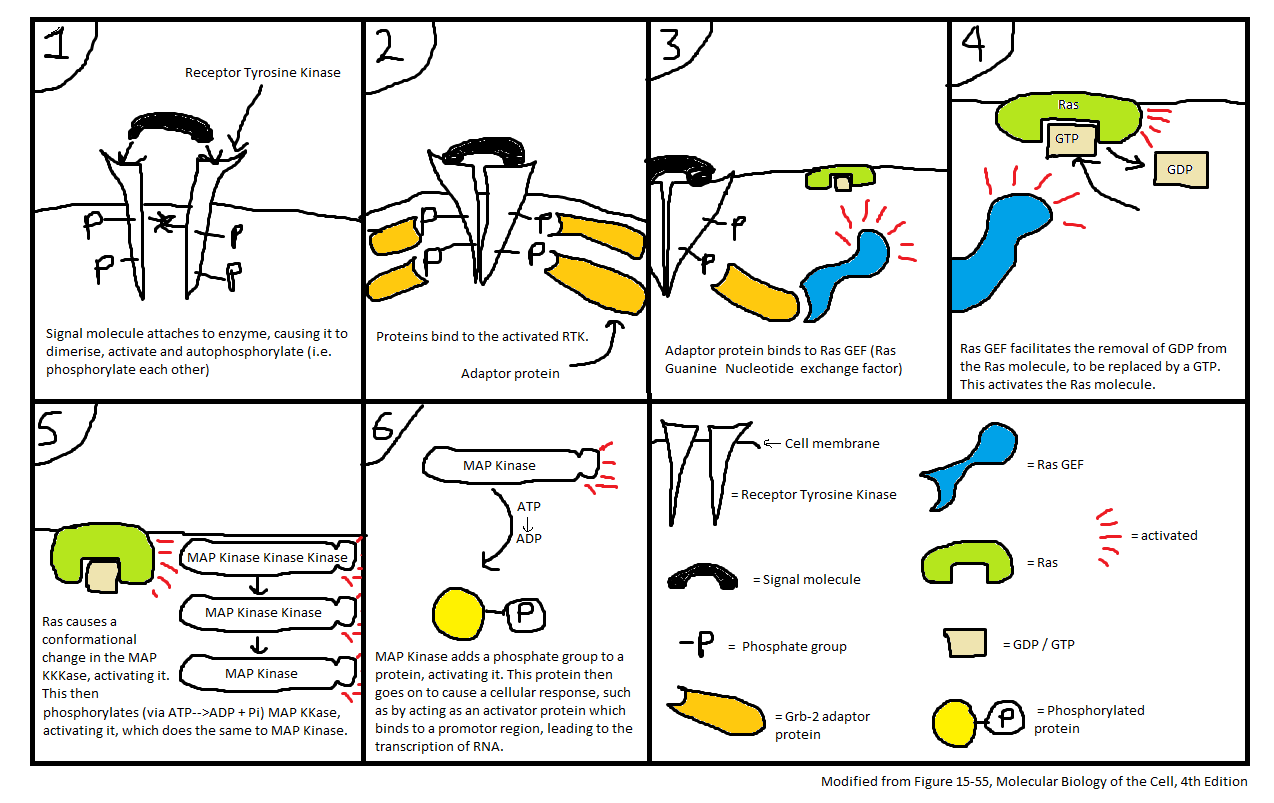Ras signalling Pathway: Difference between revisions
No edit summary |
No edit summary |
||
| Line 1: | Line 1: | ||
The Ras signalling pathway is the main pathway involved in the [[Cell signalling|transduction]] of [[Growth factors|growth factor]] signalling. It involves the dimerisation and [[Autophosphorylation|autophosphorylation]] of a [[Enzyme-coupled Receptor|receptor tyrosine kinase ]](RTK), located on the [[Cell membrane|cell membrane]], which is brought about my the binding of a [[Ligand|ligand]] (signalling molecule) to the receptor site on the RTK molecule. This triggers the binding of an adaptor protein ([[Grb-2|Grb-2]]) to the [[Phosphate|phosphate group on]] the RTK, and to that adaptor protein binds a Ras GEF molceule (Ras [[Guanine|Guanine]] Nucleotide Exchange factor) which becomes activated. This molceule facilitates the removal of [[GDP|GDP]] from a nearby Ras molecule (a monomeric [[G-proteins|G-protein]]), which is replaced by [[GTP|GTP]], and this results in the activation of the Ras. This activated Ras causes a conformational change in a nearby MAP [[Kinase|Kinase]] Kinase Kinase resulting in the activation of the molecule. Via the conversion of [[ATP|ATP]] to [[ADP|ADP]], the MAP KKKase [[Phosphorylation|phosphorylates]] a MAP Kinase Kinase, which then phosphorylates a MAP Kinase. This enzyme then phosphorylates a protein, activating it, leading to a cellular response. | The Ras signalling pathway is the main pathway involved in the [[Cell signalling|transduction]] of [[Growth factors|growth factor]] signalling. It involves the dimerisation and [[Autophosphorylation|autophosphorylation]] of a [[Enzyme-coupled Receptor|receptor tyrosine kinase ]](RTK), located on the [[Cell membrane|cell membrane]], which is brought about my the binding of a [[Ligand|ligand]] (signalling molecule) to the receptor site on the RTK molecule. This triggers the binding of an adaptor protein ([[Grb-2|Grb-2]]) to the [[Phosphate|phosphate group on]] the RTK, and to that adaptor protein binds a Ras GEF molceule (Ras [[Guanine|Guanine]] Nucleotide Exchange factor) which becomes activated. This molceule facilitates the removal of [[GDP|GDP]] from a nearby Ras molecule (a monomeric [[G-proteins|G-protein]]), which is replaced by [[GTP|GTP]], and this results in the activation of the Ras. This activated Ras causes a conformational change in a nearby MAP [[Kinase|Kinase]] Kinase Kinase resulting in the activation of the molecule. Via the conversion of [[ATP|ATP]] to [[ADP|ADP]], the MAP KKKase [[Phosphorylation|phosphorylates]] a MAP Kinase Kinase, which then phosphorylates a MAP Kinase. This enzyme then phosphorylates a protein, activating it, leading to a cellular response. | ||
[[Image: | [[Image:Enzyme Linked Receptors (Ras).png|1040x661px]] | ||
Revision as of 12:34, 17 November 2011
The Ras signalling pathway is the main pathway involved in the transduction of growth factor signalling. It involves the dimerisation and autophosphorylation of a receptor tyrosine kinase (RTK), located on the cell membrane, which is brought about my the binding of a ligand (signalling molecule) to the receptor site on the RTK molecule. This triggers the binding of an adaptor protein (Grb-2) to the phosphate group on the RTK, and to that adaptor protein binds a Ras GEF molceule (Ras Guanine Nucleotide Exchange factor) which becomes activated. This molceule facilitates the removal of GDP from a nearby Ras molecule (a monomeric G-protein), which is replaced by GTP, and this results in the activation of the Ras. This activated Ras causes a conformational change in a nearby MAP Kinase Kinase Kinase resulting in the activation of the molecule. Via the conversion of ATP to ADP, the MAP KKKase phosphorylates a MAP Kinase Kinase, which then phosphorylates a MAP Kinase. This enzyme then phosphorylates a protein, activating it, leading to a cellular response.
